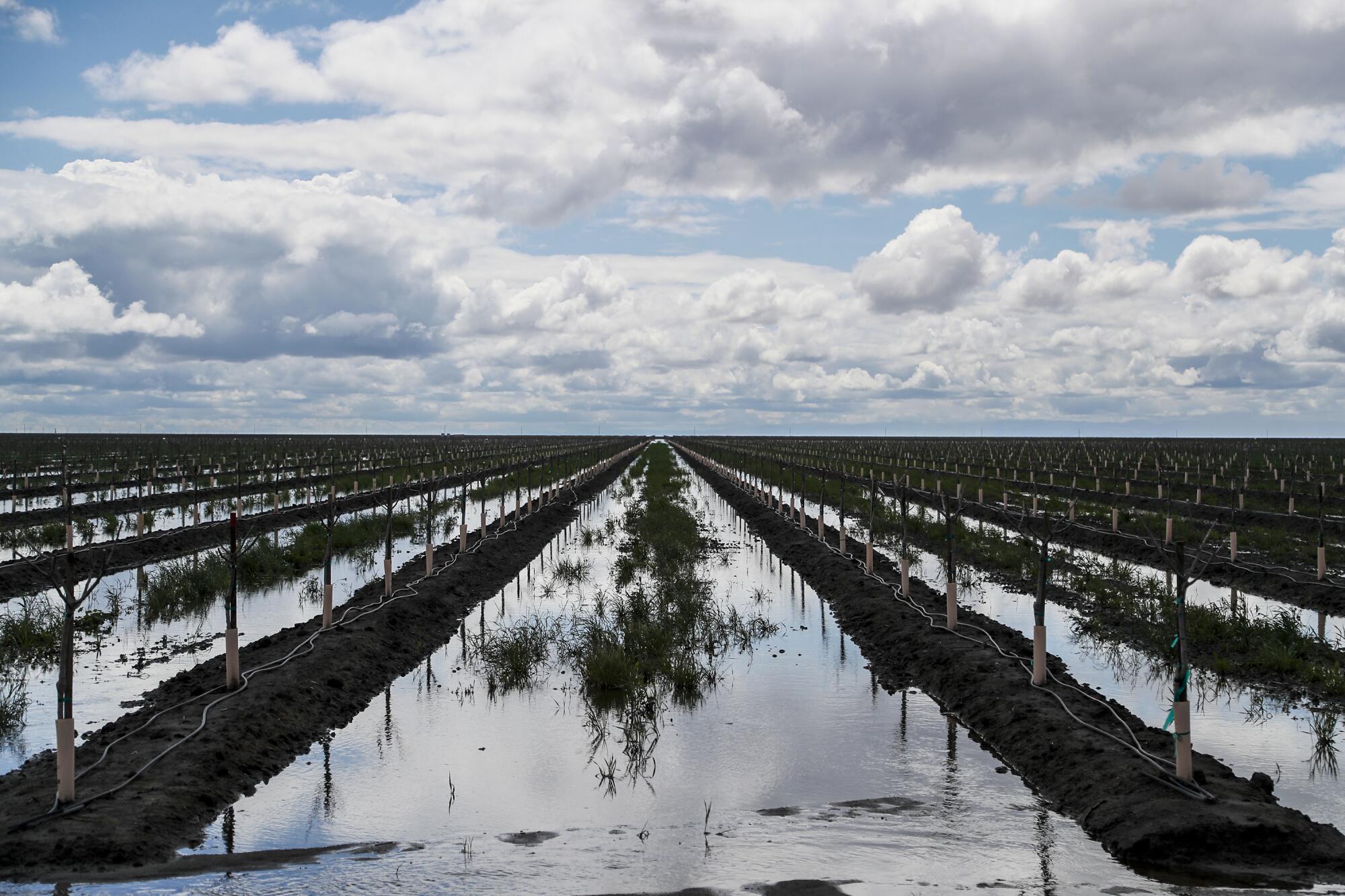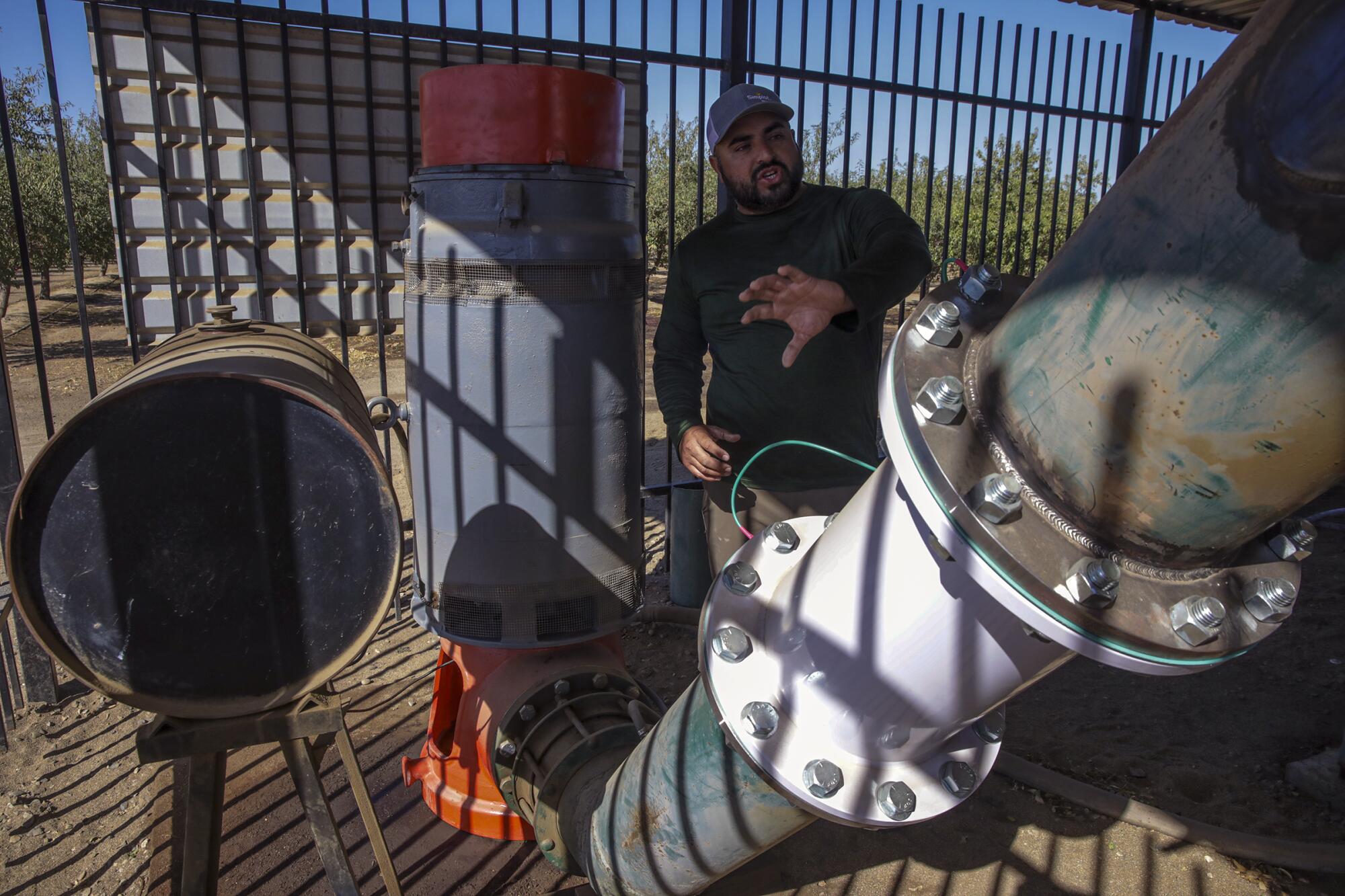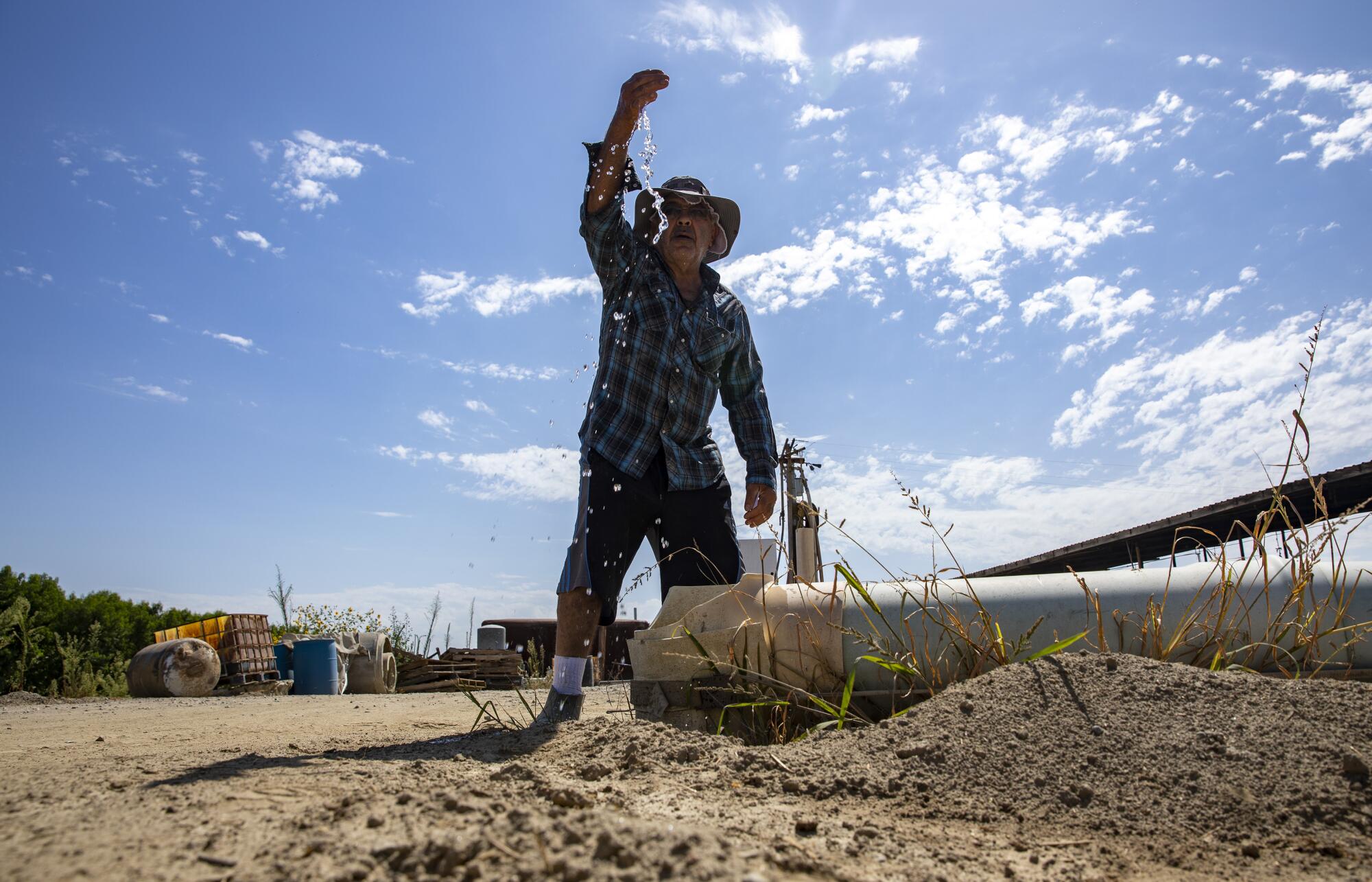California’s terribly moist 12 months introduced the state huge portions of water which have soaked into the bottom and given a considerable enhance to the state’s groundwater provides, however not almost sufficient to reverse long-term losses from over-pumping in lots of areas, in accordance with a brand new state report.
Officers with the Division of Water Assets examined water-level measurements in 1000’s of wells statewide and located that from spring 2022 to spring 2023, water ranges rose considerably in 34% of wells and declined in 9%. Others noticed little change.
The rise in aquifer ranges in lots of areas represents an enchancment from the fast and widespread declines that occurred over the past three years of utmost drought. Nonetheless, state officers cautioned that California’s groundwater stays depleted by many years of overuse.
“This 12 months, groundwater ranges started to get better from the prior drought years, however solely partially,” officers wrote within the semiannual report. “Above common precipitation throughout the state alone can’t undo the injury from years of drought. Groundwater ranges, whereas recovering, are nonetheless decrease than the interval after the 2012-2016 drought.”
The report’s authors stated it would nonetheless require “a number of extra moist years, along with extra centered efforts to extend recharge and cut back pumping, to get better from the newest drought and the cumulative depletion of groundwater aquifers that occurred over time.”

Floodwaters fill an agricultural subject amid a resurgence of Tulare Lake in March.
(Robert Gauthier / Los Angeles Instances)
The report consists of knowledge by way of August, and water managers stated it would take extra time to see the complete results of water that percolates by way of soil and sediment to aquifers.
“Water strikes very slowly inside groundwater basins, and that infiltration of floor water into the groundwater system, it does take time,” stated Steven Springhorn, a supervising engineering geologist who labored on the division’s report.
Aggressive and impactful reporting on local weather change, the setting, well being and science.
The information present extra restoration has occurred in shallow layers of aquifers. In areas the place a lot of the pumping attracts on deeper aquifers, which are sometimes tapped by agricultural wells, there was much less of an increase, Springhorn stated.
The groundwater measurements additionally present how situations fluctuate broadly from one a part of the state to a different. A few of the largest declines lately have been pushed by heavy agricultural pumping within the San Joaquin Valley, which has left many residents with dry wells.
The state report stated that among the largest current extractions of groundwater have occurred within the Tulare Lake hydrologic area, in Kings and Kern counties, and that water ranges declined greater than 5 ft in almost a 3rd of the world’s monitoring wells this 12 months, a bigger proportion than in some other hydrologic area. Since 2018, greater than 70% of the wells within the area have declined considerably.
In distinction, greater than 50% of monitoring wells elevated throughout the identical five-year interval within the closely city South Coast area.

Tejpal Singh stands subsequent to a effectively in 2021 at his household’s grape and almond farm close to Earlimart, Calif..
(Irfan Khan / Los Angeles Instances)
In farming areas of the Central Valley, water ranges have been helped in some areas by a mixture of pure recharge and state-supported recharge efforts. With extra water accessible from canals, growers and agricultural districts have additionally been capable of cut back groundwater pumping, which has helped to reduce the pressures in some areas.
Over many years, heavy pumping has drained aquifers to some extent that clay layers collapse, inflicting parts of the valley ground to sink, and completely lowering aquifer storage capability. In some areas, the bottom has sunk greater than 30 ft. The phenomenon of land subsidence has brought on injury to canals, roads and different infrastructure.
State officers stated the abundance of water throughout the just lately ended water 12 months — which runs from Oct. 1 to Sept. 30 — has slowed the speed of subsidence for now. And in a single a part of the western San Joaquin Valley the place water ranges rose considerably, the bottom floor additionally rose barely.
On this farming space, alongside the 5 Freeway within the Westlands Water District, rising water ranges have brought on this small “rebound,” Springhorn stated. Based on state knowledge, he stated, the bottom degree rose almost an inch inside a 12 months after sinking about 3 inches during the last decade — an uplift that scientists describe as a recoverable “elastic” deformation of the land floor.
The long-term pattern within the San Joaquin Valley, nonetheless, has been persevering with subsidence throughout giant stretches of farming areas.

Pacific Fuel & Electrical crews journey by airboat to decommission energy poles in a flooded pistachio orchard in Tulare Lake in June.
(Robert Gauthier / Los Angeles Instances)
State water regulators have instructed six native businesses within the San Joaquin Valley that their groundwater plans are insufficient, a step that clears the way in which for potential state intervention to power stronger measures to curb over-pumping.
The State Water Assets Management Board introduced this week that the company’s workers has really useful putting the Tulare Lake basin on probationary standing, as a result of the world’s native plan doesn’t embrace satisfactory measures to cease declines in water ranges, degradation of water high quality and fast land subsidence.
Tulare Lake was drained generations in the past and reworked into cotton and tomato fields, however this 12 months, the lake reappeared on 1000’s of acres of farmland.
State officers identified that components of Tulare Lake have sunk as much as 6 ft since 2015, which has despatched floodwaters into areas that emerged unscathed in earlier floods. To take care of the subsidence and cut back dangers, native flood management districts have needed to increase the levees that shield the town of Corcoran.
“We acknowledge that we should always begin the place issues are most pressing and options seem like additional away,” stated Natalie Stork, supervising engineering geologist for the State Water Board. “We’re very involved about potential impacts … that would happen as a consequence of continued reducing of water ranges, subsidence, water high quality degradation.”
The water board’s workers analyzed native businesses’ groundwater plan and located it will enable declines in water ranges that would go away 700 family wells dry.
Stork stated the reappearance of Tulare Lake doesn’t repair groundwater points within the space.
“The lake mattress accommodates clays that stop water from transferring into aquifers under the bottom, and the water high quality just isn’t excellent for makes use of like ingesting water,” Stork stated.
The board scheduled an April 16 listening to to think about whether or not to position the basin and its 5 native groundwater administration businesses on probationary standing. If the board decides to place the world on probation, most effectively homeowners could be required to start out reporting their water utilization and begin paying pumping charges, amongst different necessities.
The motion is the state’s newest step in implementing the 2014 Sustainable Groundwater Administration Act, which requires native businesses to develop plans and curb over-pumping by 2040 in lots of areas.

Frank Ferriera pulls a handful of recent water from a big open pipe at his farm in Visalia final 12 months.
(Brian van der Brug / Los Angeles Instances)
Farms within the Central Valley have lengthy trusted groundwater to provide crops corresponding to almonds and grapes.
Regardless of this 12 months’s historic snowpack and report rainfall in components of the state, California has acquired a lot much less precipitation since 2000 than the twentieth century common.
State water officers describe this because the “collected precipitation deficit,” reflecting repeated droughts alongside the consequences of local weather change.
“As California transitions to a hotter and drier local weather, this state of affairs of persistent groundwater depletion turns into more and more doubtless, additional emphasizing the significance of sustainable groundwater administration,” state officers wrote within the report.
In moist years, groundwater sometimes accounts for 30% to 40% of the state’s water use, however in dry years, that usually grows to about 60% of water utilization.
The elevated pumping throughout droughts has led to particularly giant drawdowns. Based on state knowledge, about 1,500 dry family wells had been reported throughout the extreme drought final 12 months.
This 12 months, greater than 400 dry wells have been reported, a lot of them in farming areas of the Central Valley.
The moist climate additionally affected the drilling of latest wells. Based on the report, fewer new wells had been drilled in 2023 than in any 12 months since 2014.
The newest knowledge underline the significance of continued efforts to handle groundwater, Springhorn stated.
“Generally it’s out of sight, out of thoughts,” Springhorn stated, “however it’s so essential for the state’s general water resiliency.”
E-newsletter
Towards a extra sustainable California
Get Boiling Level, our publication exploring local weather change, power and the setting, and develop into a part of the dialog — and the answer.
It’s possible you’ll sometimes obtain promotional content material from the Los Angeles Instances.
#Californias #epic #moist #12 months #helped #enhance #groundwater #ranges
